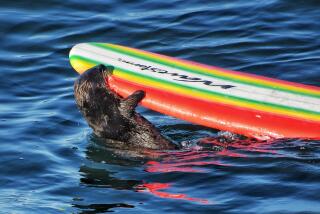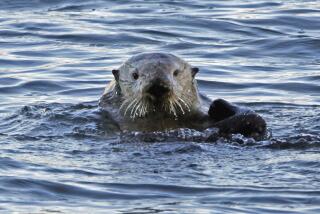Otters’ comeback could be a trap for some

- Share via
With an expert’s eye, trapper Irv Schirmer spots the pieces of fresh willow floating in a pond near the town of Marengo and notes the worn shoreline and flattened grass trails that run to the banks of the nearby Kishwaukee River.
These are telltale signs of unwelcome visitors — the beaver and another critter that Schirmer is eager to find, the river otter.
Starting this month, new opportunities await him with the opening of the state trapping season, the first time that it has been legal to trap otters in Illinois in 83 years.
Once listed as endangered in the state, otters are increasing in number, thanks to improved habitat and state preservation programs, according to wildlife officials who say the population is now big enough to support an annual harvest. Five otters can be trapped per person.
Known for their playfulness and curiosity, otters are also brazen fish pilferers.
Fish farms have discovered otters helping themselves. So have private pond owners, who have complained about finding piles of fish heads or fish scales along the banks, indicators that otters have been dining there, said Bob Bluett, a wildlife biologist with the Illinois Department of Natural Resources.
“When you go to the pond with your grandkids to fish, and you find ... fish heads, well, that’s not what you had in mind,” Bluett said. “We had otters stealing people’s fish out of their baskets, hanging out on the docks.... They have the ability to adapt to people.”
Bluett said the growth of the state’s otter population to a size that officials believe can support a trapping season is “a success story many times over.”
River otters were common here during early settlements. But before the 1900s, there were no regulations to protect them from over-harvesting, and habitat was lost to agriculture, Bluett said.
Numbers declined by the early 1900s, and the state closed the trapping season in 1929. In 1977, the state listed the otter as a threatened species. By 1989, its status was changed to “endangered,” a more serious classification, as experts found fewer than 100 otters in Illinois.
Illinois’ recovery program began in the early 1990s but really took off from 1994 to 1997, when the state obtained 346 otters from a Louisiana trapper. The agency released the animals into three Illinois river basins.
The Department of Natural Resources estimates that 15,000 to 20,000 otters now live in Illinois. The population could hit 30,000 by 2014 if left unchecked, Bluett said.
Cleaner waterways have helped fish populations recover, allowing for a greater diversity of fish species — the primary food for the otter, officials said.
Conservation practices to reduce runoff into streams and rivers also have improved the otter’s habitat.
“The fact that we can have a river otter season in 2012 is exciting in a lot of ways,” Bluett said. “It chronicles direct things we’ve done, but also those improvements that aren’t quite so measurable over time.”
When the new trapping season begins, Schirmer will be on the lookout for raccoons as well as otters. He recalled that in his biggest season he trapped 400 raccoons.
Schirmer said he trapped 80 beavers in one of his biggest seasons. There were years he netted 40 to 60 skunks, and two years ago, he said, he trapped 22 coyotes along the one-mile road that runs past his farm in McHenry County in northern Illinois.
Among trappers, the word is already out that pelting the muscular, torpedo-shaped body of an otter is hard work and needs to be done correctly to prevent any waste.
“A good sportsman knows no animal should be killed and wasted. Everything should be used to the fullest extent,” Schirmer said.
More to Read
Sign up for Essential California
The most important California stories and recommendations in your inbox every morning.
You may occasionally receive promotional content from the Los Angeles Times.













